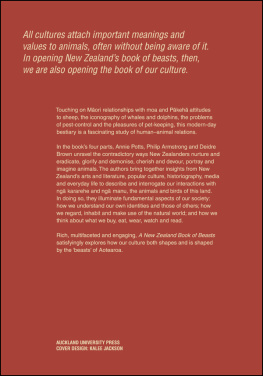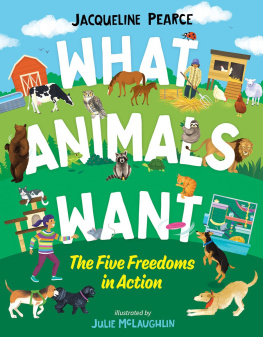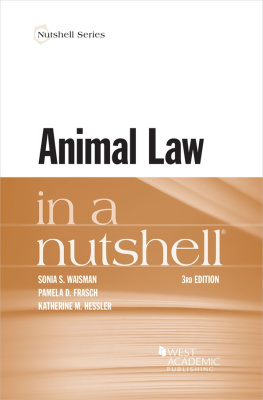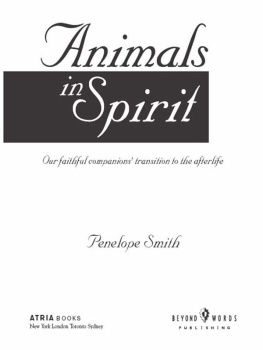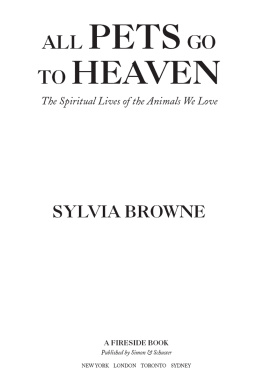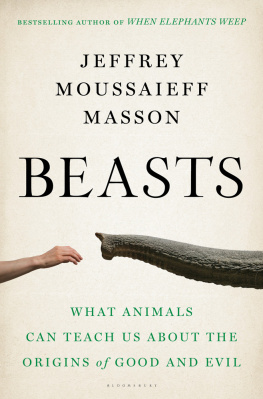A New Zealand
Book of Beasts
Animals in our Culture,
History and Everyday Life
Annie Potts
Philip Armstrong
Deidre Brown

We lovingly dedicate this book to Deidres father,
Albert (Jim) James Brown (19222008), and to
Annies mother, Faith Katrina Potts (19332011).
Contents
Philip Armstrong
Annie Potts
Deidre Brown
Annie Potts
Introduction
A leg of lamb, butcher-dressed, oven-ready. A portrait of the extinct South Island kkako (Callaeas cinerea cinerea). These two things seem to have nothing to do with each other, so why are they together at the centre of Maryrose Crooks painting Lamb of Constant Sorrow ()? By superimposing one upon the other so that the image of the recently extinct bird appears to be emblazoned or branded onto the flesh of the recently dispatched lamb the painting invites its viewers to make some kind of connection between these two dead animals.
The lamb joint, with its avian tattoo, lies on a bed of luxurious pink silk, surrounded by gem-like icons: a bejewelled cross and an eye with pendant pearl tears, surmounted by a crown. Presented in this way, as though for some ritual display, these objects seem to call out for symbolic interpretation, which would be easy enough to make: a leg of lamb and an extinct endemic bird both have pretty clear and immediate iconographic associations. The kkakos song is generally considered the most beautiful of any New Zealand bird, and since one of its subspecies has recently been declared extinct while the other remains critically endangered, the bird seems an obvious representative for the lost or severely threatened endemic natural beauty that remains one of New Zealands standard defining features. Operating in a rather different register, the leg of lamb is an emblem of the pastoral agriculture upon which, according to a still-current historical truism, modern New Zealand was founded both economically and culturally. Lamb and bird, then, symbolise two of the most familiar constituents of New Zealand national identity.
Very different connotations arise, however, as soon as we think of this leg of lamb and this bird not as symbols but as realities. Once again, features of their presentation in the painting invite us to do so. The colours and textures of the voluptuously rumpled silk resemble those of the cut meat and its glistening sheath of fat. But the viewer knows those visual similarities are misleading: if this were a real leg of lamb sitting on real silk, the meat would be cold and slimy-sticky to the touch, whereas the material would be as smooth and softly warm as it looks to say nothing of the difference in smell. Part of the force of Crooks painting arises from this uncomfortable discordance between the visual appeal of the lamb and bird and the material realities to which they draw attention.
Material in two senses: not just what the pictured objects would be like in real life, but also what kinds of practical, everyday realities their presence (or absence) entails. Thinking this way reveals a very material and direct relationship between the leg of lamb and the extinct bird. Because of their diet and habits, kkako need large unbroken areas of diverse forest. Unfortunately for them, large-scale sheep-farming has always demanded the exact opposite: vast areas of monoculture pastureland. Forest clearance for agricultural purposes and the decline of endemic forest species are different sides of the same story; the extinction of one of the species in Crooks painting is causally related to the life and death of the other.
By inspiring us to read its animal subjects both symbolically and materially, Lamb of Constant Sorrow also challenges us to think about how we organise our feelings and our knowledge about animals. The opulent display raises questions about value. How do we assign worth to different kinds of animals? How do we decide which should live and which should die? The superimposition of extinct bird on dead meat creates a vivid contrast between two different humananimal sensibilities: our relationship with food animals and our relationship with rare native species. Yet this contrast obscures a connection: although we place these animals in completely different categories, there are in fact very real relationships between them which, although they are not hidden, are seldom addressed (for example, the impact of pastoralism on native species).
The paintings religious iconography, including its title, also reminds us that we are capable at the same time of treating the very same species of animal simultaneously as mere raw material (livestock), as the object of sentimental veneration (in springtime, New Zealand city folks take their children into pastureland to see the new lambs), and as the most sacred of Christian religious icons (the Lamb of God). In this sense the painting invokes not animals themselves but the numerous and often contradictory categories that we employ to organise our relationships with them. Stock animal, food animal, iconic animal, sacred animal; endangered, protected, extinct animal; native, endemic and introduced animal; pet and pest animal: each modifier that we attach to the word animal evokes differences not amongst animals themselves but in how our cultures value and treat them. And yet this taxonomy is fundamentally illogical and pervasively self-contradictory: its categories are not self-contained, nor generated by consistent principles of selection, nor mutually exclusive. Lamb, as Crooks painting shows, could go in half a dozen of the categories listed above; so could rabbit, dog, paradise duck, kerer, moa, possum, dolphin, whale The diagrammatic table of New Zealanders relationships to animals, then, has little in common with the abstract ideal of a logical taxonomy; it is much more like the apocryphal Chinese Encyclopaedia famously evoked by Jorge Luis Borges, in which
it is written that animals are divided into: (a) those that belong to the emperor; (b) embalmed ones; (c) those that are trained; (d) suckling pigs; (e) mermaids; (f) fabulous ones; (g) stray dogs; (h) those that are included in this classification; (i) those that tremble as if they were mad; (j) innumerable ones; (k) those drawn with a very fine camels-hair brush; (l) etcetera; (m) those that have just broken the flower vase; (n) those that at a distance resemble flies.
Maryrose Crooks painting, like Borges encyclopaedia, has a defamiliarising effect on our taken-for-granted attitudes to and relationships with animals. We are invited to notice how odd, how paradoxical and inconsistent, and how artificial are the ways in which humans think about and behave towards other living species and yet, at the same time, how natural these thoughts and behaviours seem to us.
Since the meanings and values that we attach to animals are shaped by culture, moreover, they are inextricably bound up with questions of cultural difference and cultural politics. Lamb of Constant Sorrow invites the viewer to reflect on these questions too. The kkako, with its charismatic music, can be interpreted as a symbol not only of the endemic nature but also of the indigenous human culture of these islands, while the leg of lamb is emblematic of European colonialism as well as pastoralism. Seen in this light, Crooks painting reminds us of the historical and economic forces that have endangered te ao Mori, just as forest clearances for agriculture have decimated the kkako. Ongoing contemporary threats to indigenous culture are also suggested: for example, the ways in which tikanga Mori can be appropriated and exploited today, in the context of global commodity capitalism, are indicated by the kkakos apparent reduction to a logo or branding device for the agricultural product upon which it appears. Crooks work remind us, then, that in examining the role of animals in culture we are also always required to think about the relationships between cultures relationships that can involve mutual influence and cooperation, but also appropriation, exploitation and erasure.

